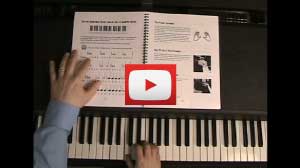Blues Piano
Blues piano is the forerunner of American popular music. From blues and Ragtime came jazz, and from blues and boogie woogie came Rock and Roll. Though there have been changes and some evolution, piano blues today is essentially the same as it was a century ago.
We will present a brief history of blues piano, and take you to some of the places where it developed.
Blues Piano History
Early Blues Piano
Blues music first developed toward the end of the nineteenth century. Black field hands, sharecroppers, levy workers and lumbermen mixed their spirituals, folk songs and work songs to create a new music. What evolved was a 12 measure song form built loosely around a I-IV-V chord progression, becoming a standard progression used today in jazz, rock and country as well as blues.
The earliest reports of piano blues dates back to around the turn of the century in the lumber and turpentine camps of Louisiana and Texas. At that time every saloon, hall or gathering place had a piano. Some of these establishments were simply shacks or tents with barrels of beer or other "refeshments," and became known as "barrellhouses." The atmosphere was loud and energetic, and usually the piano was way out of tune. These factors led to the piano player's need to play hard and fast. Hard to keep up with the volume of the crowd, and fast to minimize the sound of the out of tune notes.
More about early blues pianists: George and Hersal Thomas, Clarence Williams, Cow Cow Davenport
Boogie Woogie Piano
Because the blues pianist often performed alone, they made a style that sounded like a one-man band. The pianist very rhythmicly provided the bass, chords and melody. The style came to be known as "Barrellhouse piano" or "boogie woogie."
The blues became part of the wider culture with trumpeter W.C.Handy's publication of "The Memphis Blues" and later "St. Louis Blues" in the early teens. Soon the blues was played in the cities. Boogie woogie was the music of rent parties in Chicago, New York and elsewhere.
The blues craze of the twenties featured strong women singing bawdy songs. Bessie Smith, Mamie Smith and others sang "classic blues" often accompanied by piano.
Boogie woogie grew in popularity through the 1920's, but by the early 30's bands were in and solo piano was out. That changed in 1938 with a concert at Carnegie Hall featuring Albert Ammons, Meade Lux Lewis and Pete Johnson, setting off a new boogie woogie craze that lasted into the early '50's.
Jump Blues Piano
During the 1930's, the blues was played by swing orchestras like Count Basie's, and in the '40's, small bands featuring the piano and a few horns plus a rhythm section made a new "city" blues for dancing. This "jump blues" became the dance music of the post-war period, and was the precursor to the Rock and Roll music of the 1950's. On the west coast, and mostly in Los Angeles, a smooth, mid-tempo blues became popular with Charles Brown being the biggest piano blues hitmaker in this genre.
New Orleans Blues Piano
In New Orleans, the birthplace of jazz, is also the place where early blues got a start. In New Orleans the piano remained a driving force in the local music scene, shaping the sound of the jazz, blues, R&B and rock and roll that originated there.
Chicago Blues Piano
In Chicago, the blues became electrified, and piano was a part of the blues band sound that also featured guitars, harmonicas, bass and drums.
Start Playing Piano Today with the Piano Guide Quick Start Course!
Easy to follow step-by-step lessons designed for adult beginners. The next best thing to private lessons!
What You'll Learn:
- Notes on the piano/keyboard
- Proper fingering
- C major scale
- Chords
- How to read music
- And much more!

Video lessons - watch as I play everything for you.

